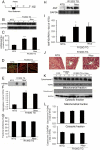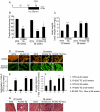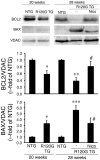Cardioprotective effect of nicorandil, a mitochondrial ATP-sensitive potassium channel opener, prolongs survival in HSPB5 R120G transgenic mice
- PMID: 21541347
- PMCID: PMC3081834
- DOI: 10.1371/journal.pone.0018922
Cardioprotective effect of nicorandil, a mitochondrial ATP-sensitive potassium channel opener, prolongs survival in HSPB5 R120G transgenic mice
Abstract
Background: Transgenic (TG) mice with overexpression of an arg120gly (R120G) missense mutation in HSPB5 display desmin-related cardiomyopathy, which is characterized by formation of aggresomes. It is also known that progressive mitochondrial abnormalities and apoptotic cell death occur in the hearts of R120G TG mice. The role of mitochondrial dysfunction and apoptosis in disease progression, however, remains uncertain.
Methods and results: Mitochondrial abnormalities and apoptotic cell death induced by overexpression of HSPB5 R120G were analyzed in neonatal rat cardiomyocytes. Overexpression of mutant HSPB5 led to development of aggresomes with a concomitant reduction in cell viability in the myocytes. Overexpression of mutant HSPB5 induced a reduction in the cytochrome c level in the mitochondrial fraction and a corresponding increase in the cytoplasmic fraction in the myocytes. Down-regulation of BCL2 and up-regulation of BAX were detected in the myocytes expressing the mutant HSPB5. Concomitant with mitochondrial abnormality, the activation of caspase-3 and increased apoptotic cell death was observed. Cell viability was dose-dependently recovered in myocytes overexpressing HSPB5 R120G by treatment with nicorandil a mitochondrial ATP-sensitive potassium channel opener. Nicorandil treatment also inhibited the increase in BAX, the decrease in BCL2, activation of caspase-3 and apoptotic cell death by mutant HSPB5. To confirm the results of the in-vitro study, we analyzed the effect of nicorandil in HSPB5 R120G TG mice. Nicorandil treatment appeared to reduce mitochondrial impairment and apoptotic cell death and prolonged survival in HSPB5 R120G TG mice.
Conclusions: Nicorandil may prolong survival in HSPB5 R120G TG mice by protecting against mitochondrial impairments.
Conflict of interest statement
Figures








Similar articles
-
Nicorandil improves electrical remodelling, leading to the prevention of electrically induced ventricular tachyarrhythmia in a mouse model of desmin-related cardiomyopathy.Clin Exp Pharmacol Physiol. 2014 Jan;41(1):89-97. doi: 10.1111/1440-1681.12185. Clin Exp Pharmacol Physiol. 2014. PMID: 24117876
-
Protective effect of geranylgeranylacetone via enhancement of HSPB8 induction in desmin-related cardiomyopathy.PLoS One. 2009;4(4):e5351. doi: 10.1371/journal.pone.0005351. Epub 2009 Apr 28. PLoS One. 2009. PMID: 19399179 Free PMC article.
-
Exercise reverses preamyloid oligomer and prolongs survival in alphaB-crystallin-based desmin-related cardiomyopathy.Proc Natl Acad Sci U S A. 2007 Apr 3;104(14):5995-6000. doi: 10.1073/pnas.0609202104. Epub 2007 Mar 26. Proc Natl Acad Sci U S A. 2007. PMID: 17389375 Free PMC article.
-
Nicorandil inhibits oxidative stress-induced apoptosis in cardiac myocytes through activation of mitochondrial ATP-sensitive potassium channels and a nitrate-like effect.J Mol Cell Cardiol. 2003 Dec;35(12):1505-12. doi: 10.1016/j.yjmcc.2003.09.018. J Mol Cell Cardiol. 2003. PMID: 14654376
-
Molecular mechanisms of α-crystallinopathy and its therapeutic strategy.Biol Pharm Bull. 2011;34(11):1653-8. doi: 10.1248/bpb.34.1653. Biol Pharm Bull. 2011. PMID: 22040875 Review.
Cited by
-
9-Phenanthrol, a TRPM4 inhibitor, protects isolated rat hearts from ischemia-reperfusion injury.PLoS One. 2013 Jul 25;8(7):e70587. doi: 10.1371/journal.pone.0070587. Print 2013. PLoS One. 2013. PMID: 23936231 Free PMC article.
-
Therapeutic potential of nicorandil beyond anti-anginal drug: A review on current and future perspectives.Heliyon. 2024 Mar 31;10(7):e28922. doi: 10.1016/j.heliyon.2024.e28922. eCollection 2024 Apr 15. Heliyon. 2024. PMID: 38617945 Free PMC article. Review.
-
Cardiac overexpression of constitutively active Galpha q causes angiotensin II type1 receptor activation, leading to progressive heart failure and ventricular arrhythmias in transgenic mice.PLoS One. 2014 Aug 29;9(8):e106354. doi: 10.1371/journal.pone.0106354. eCollection 2014. PLoS One. 2014. PMID: 25171374 Free PMC article.
-
Nicorandil prevents right ventricular remodeling by inhibiting apoptosis and lowering pressure overload in rats with pulmonary arterial hypertension.PLoS One. 2012;7(9):e44485. doi: 10.1371/journal.pone.0044485. Epub 2012 Sep 7. PLoS One. 2012. PMID: 22970229 Free PMC article.
-
Effects of adding intravenous nicorandil to standard therapy on cardiac sympathetic nerve activity and myocyte dysfunction in patients with acute decompensated heart failure.Eur J Nucl Med Mol Imaging. 2015 Apr;42(5):761-70. doi: 10.1007/s00259-015-2990-0. Epub 2015 Jan 30. Eur J Nucl Med Mol Imaging. 2015. PMID: 25634117 Clinical Trial.
References
-
- IONA Study Group. Determinants of coronary events in patients with stable angina: results from the impact of nicorandil in angina study. Am Heart J. 2005;150:689. - PubMed
-
- Das B, Sarkar C. Mitochondrial K ATP channel activation is important in the antiarrhythmic and cardioprotective effects of non-hypotensive doses of nicorandil and cromakalim during ischemia/reperfusion: a study in an intact anesthetized rabbit model. Pharmacol Res. 2003;47:447–461. - PubMed
-
- IONA Study Group. Effect of nicorandil on coronary events in patients with stable angina: the Impact Of Nicorandil in Angina (IONA) randomised trial. Lancet. 2002;359:1269–1275. - PubMed
-
- Nishikawa S, Tatsumi T, Shiraishi J, Matsunaga S, Takeda M, et al. Nicorandil regulates Bcl-2 family proteins and protects cardiac myocytes against hypoxia-induced apoptosis. J Mol Cell Cardiol. 2006;40:510–519. - PubMed
Publication types
MeSH terms
Substances
LinkOut - more resources
Full Text Sources
Molecular Biology Databases
Research Materials
Miscellaneous

